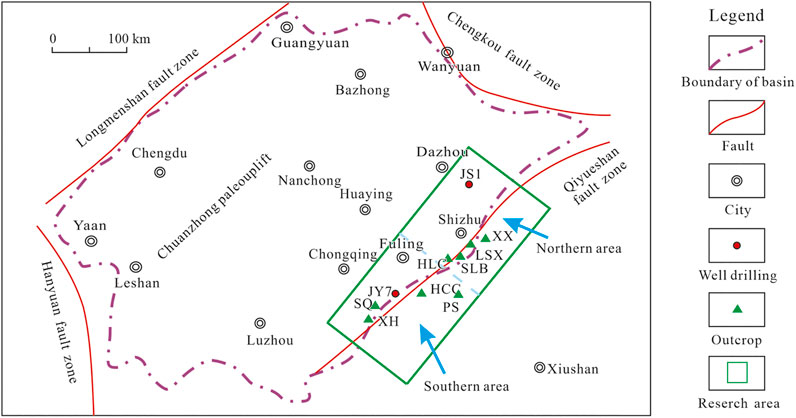- School of Geoscience and Technology, Southwest Petroleum University, Chengdu, China
By means of thin section authentication, physical characteristics analysis, scanning electron microscopy (SEM), X-ray diffraction, and vitrinite reflectance analysis, this paper, based on regional geological research achievements, studies the sedimentary facies and diagenesis of the southern and northern Silurian Xiaoheba Formation areas of Southeast Sichuan and their relationships with the physical characteristics of the reservoirs. The results indicate that, in the northern study area, the microfacies are mainly deposited in the underwater distributary main channel of the distal shallow-water delta front; while in the south, the microfacies include an estuary bar, sheet sand, distal bar, and interdistributary bay, which are far away from the main channel. The physical characteristics of sandstone are positively correlated with its particle sizes and thickness. The sand body of the underwater distributary main channel microfacies features high porosity, large crack opening, and good connectivity, followed by the sandstone of the estuary bar microfacies regarding those characteristics. By contrast, the physical characteristics of the sandstone reservoirs corresponding to the microfacies including the distal bar, sheet sand, and interdistributary bay are poor. The Xiaoheba Formation reservoir is located in the late diagenetic stage, with the reservoir space dominated by dissolved pores and micro-cracks; the diagenesis and pore evolution in the south are significantly different from those in the north. The Xiaoheba Formation reservoir in the northern area is far away from the carbonate rock platform of the same period in the south but is close to the center of hydrocarbon generation. Besides, the reservoir was sufficiently reformed by organic acid dissolution in the early-medium diagenetic stage, with only a little carbonate cementation formed in the early stage, while the cementation in the late diagenetic stage was weak. Therefore, the reservoir pores were relatively well preserved. However, the Xiaoheba Formation reservoir in the southern area has a large amount of calcite cement that was formed in the early diagenetic stage and the pores were blocked due to the influence of the carbonate platform. Since the dissolution was weak at the same time, the reservoir in the southern area is tight. Based on the understanding above, this paper established the inhomogeneous sedimentation–diagenesis–reservoir formation mode of the northern and southern areas of the study area.
1 Introduction
The physical characteristics of a reservoir are usually jointly determined by sedimentary environment, sediment composition, and diagenesis (Ajdukiewicz and Lander, 2010; Li et al., 2018; Zhang et al., 2020; Zhang et al., 2022a; Zhang et al., 2022b); while sedimentation and diagenesis not only go through the whole process of reservoir development and evolution, they also influence the current characteristics of the reservoir. Previous researchers conducted systematic studies from the perspectives of the control of various types of diagenesis on physical characteristics (Ali et al., 2010; Taylor et al., 2010; Cao et al., 2018; Mahmic et al., 2018; Cao et al., 2019; Cao et al., 2020), the effect of factors like mud matrix and sedimentary facies belts on diagenesis, and consequent evolution of physical characteristics. (Tan et al., 2015; Cao et al., 2016; Tan et al., 2016; Haile et al., 2018; Khan et al., 2020; Luo et al., 2020; Bello et al., 2021). Further, with the consideration of the constraint on diagenesis by sedimentary environment and tectonic setting, the research on the systematic process of sedimentation–diagenesis–reservoir formation has become a hot research topic currently.
The Sichuan Basin is rich in oil and gas resources. Up to now, in the field of clastic rock exploration in the Sichuan Basin, good achievements have been made in the Upper Triassic Xujiahe Formation and the Jurassic stratum. Meanwhile, the deep tight clastic rock of the Silurian Xiaoheba Formation is the hot spot for oil and gas exploration as well as one of the critical substitute targets (Zou, 2003; Yang and Ji, 2009; Higgs et al., 2010; Jia and Zou, 2012; Zou et al., 2012; Liu et al., 2015; Feng et al., 2016; Zhu and Zhang, 2016; Olsen et al., 2017; Wu et al., 2017; Zhou et al., 2017; Gao et al., 2018; Pan et al., 2018; Wang et al., 2019). The difference in the process of sedimentation and diagenesis between the northern and southern areas of the study area is mainly demonstrated in rock assemblage, cement types, and development level. Some studies suggested that compaction and cementation would destroy the physical characteristics of the reservoir but dissolution was constructive to them (Cao and Jiang, 2002; Shi et al., 2009). However, due to the difference in sedimentary facies between the northern and southern areas and the complexity and diversity of the diagenesis environment and evolution process in both areas, it will be insufficiently detailed if the sedimentation—diagenesis—reservoir formation is characterized in a generalized way for both of them. Therefore, on the basis of previous achievements on regional structure, sedimentation, and reservoir forming (Hou et al., 2010; Wang et al., 2011a; Wang et al., 2011b; Xie et al., 2011; Zhu and Chen, 2012; Li et al., 2015; Gong et al., 2017; Hu et al., 2017; Zhang et al., 2017; Qiu et al., 2019), the author carried out research into the sedimentary facies and diagenesis and their relationships with the physical characteristics and established an inhomogeneous mode of sedimentation—diagenesis—reservoir formation based on the thin section authentication, SEM analysis, and physical characteristics analysis of the cores in combination with the techniques including particle size analysis, X-ray diffraction analysis, and vitrinite reflectance analysis. It can not only deepen the understanding about the sedimentation—diagenesis—pore evolution of deep marine clastic rock reservoirs, but also is of practical importance for implementing exploration potential and objectives.
2 General Geological Condition
The study area, located in the Eastern Sichuan high-steep tectonic zone and the Southern Sichuan low-gentle tectonic zone, belongs to the central area of the Upper Yangtze foreland basin in the south-central Yangtze Plate, including the northern margin of the Qianzhong Uplift, north to the Central Sichuan Uplift in terms of tectonic position (He et al., 2013). The Qiyueshan Fault Zone is located in the area and therefore the area is tectonically complex (Figure 1).
The Xiaoheba Formation sedimentation was formed in the late stage of Early Silurian. Influenced by the Caledonian Movement, the South China Plate was compressed and joined along the direction from southeast to northwest. The Yangtze Plate was raised as a whole, and the Xiaoheba Formation sedimentary center was gradually migrated northwest, with the water becoming shallower upward, finally forming a set of shallow-water delta sedimentation in the study area. This sedimentation is mainly distributed in the Qiliao section of Shizhu—Sanquan section of Nanchuan—Pengshui—Xiushan zone, running through the study area from north to south and with a thickness of 200–300 m. It is longitudinally between the Longmaxi Formation lime muddy shale and the Hanjiadian Formation thick shale, with sufficient hydrocarbon source rocks as the material guarantee and simultaneously extremely thick shale as the capping layer, resulting in a good formation of hydrocarbon generation, reservation, and capping. Multiple sets of silty-fine sandstones were developed at the bottom of the Xiaoheba Formation, but the thickness and scale of the sandstone vary sharply between different areas and the sandstone content at the bottom gradually decreases from bottom to top. Based on the characteristics of the sequence stratigraphy, the Xiaoheba Formation is divided into two sections, respectively Section 1 and Section 2 from the old stratum to the young stratum. They each correspond to two third-order sequences, of which the sequence boundary has strong regional contrast. Additionally, the Shiniulan Formation, located to the south of the study area from Fuling to well JY7 and formed in the same period with the Xiaoheba Formation, is a set of marine carbonate rocks with restricted platform facies, platform edge shallow facies, platform-margin organic reef facies, platform-margin slope facies, and continental shelf facies.
3 Sedimentary Characteristics
During the sedimentation stage of the Xiaoheba Formation, the southeastern Sichuan Basin mostly featured the sedimentary setting of gentle slopes, shallow water, and sufficient sources, which was favorable for the formation of the shallow-water delta. Its microfacies are dominated by an underwater distributary main channel, underwater distributary branch channel, and estuary bar, with the sand body distribution clearly controlled by the distributary channels. Therefore, it has the characteristics of multi-branch distributary channels with vast distribution and far extension, and fine particle sizes of sandstone. The developed multiple-stages delta sand bodies are superimposed longitudinally upwards; while in plane, the sand body shows a continuous advance from south-east to north-west.
In the northern part of the study area from Shizhu to well JS1, the Xiaoheba Formation mainly developed the shallow-water delta front underwater distributary main channel facies, with numerous channel sand bodies developed in its Section 1 and Section 2. Those sand bodies are mostly thick-bedded, massive, and lithologically dominated by silty-fine sandstone interbedded with thin-bedded mudstone, with pebbled fine sandstone in local parts and clear down-cutting erosion surfaces at the sand body bottom (Figure 2A). The longitudinal middle of the sand bodies has developed parallel bedding and cross bedding while the top of the sand bodies have symmetric wave ripples (Figure 2B). The particle size of the sand bodies, which are dominated by normal graded bedding, generally becomes finer upwards. According to the characteristics of the particle size probability curves, this area features the typical two-segment characteristics of delta channels, indicating the existence of river deposition with strong hydrodynamic force in this area (Figure 3).
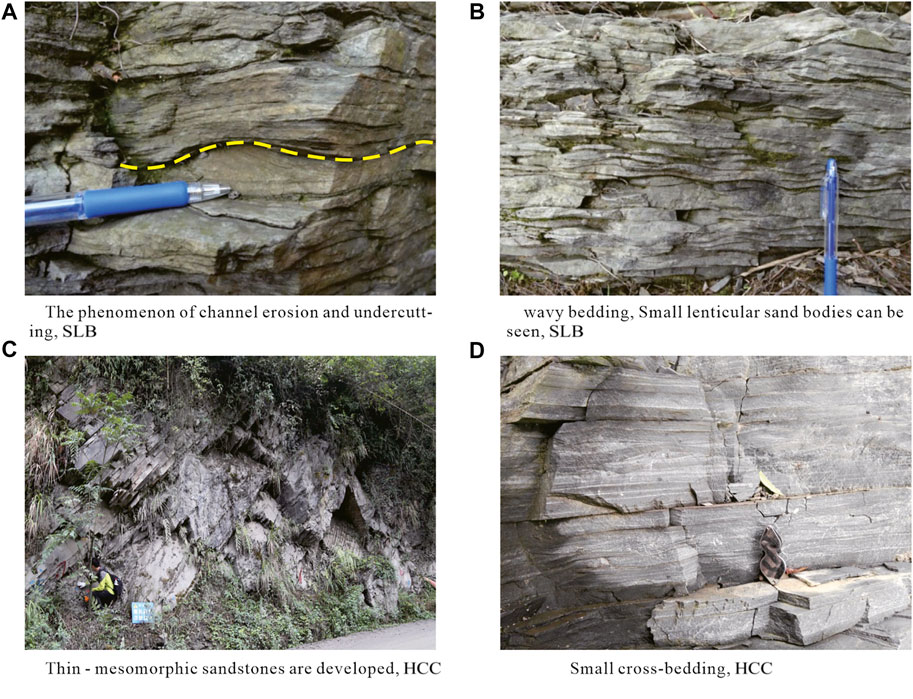
FIGURE 2. Field sedimentary structure of Xiaoheba Formation (A) The phenomenon of channel erosion and undercutting, SLB, (B) wavy bedding, small lenticular sand bodies can be seen, SLB, (C) Thin—mesomorphic sandstones are developed, HCC; (D) Small cross-bedding HCC.
The sandstone thickness of the Xiaoheba Formation in the southern part of the study area becomes thinner, with finer particle sizes and high shale content. The sand bodies feature thin-moderate layers in morphology, and are lithologically dominated by siltstone and argillaceous sandstone, with fine sandstone locally distributed and parallel bedding and small cross bedding developed at the same time (Figures 2C,D). They have clear down-cutting erosion surfaces at the bottom and symmetric wave ripples developed on the top sandstone, with normal and abnormal graded bedding simultaneously developed. Therefore, the Xiaoheba Formation in the southern part of the study area features the delta front underwater distributary branch channel facies far away from the main channel in the north.
3 Reservoir Characteristics
3.1 Petrologic Features
According to the accurate observation and description regarding multiple outcrops in Southeast Sichuan and the thin section authentication of samples, the sand bodies of the Xiaoheba Formation reservoir in Southeast Sichuan generally have fine particle sizes. In the northern area, the particle sizes are relatively coarse and dominated by coarse silt, with a few of the particle sizes at the grade of extremely fine sand. The quartz sandstone is the main rock type (Figure 4A) and accounts for about 41.7%, followed by lithic quartz sandstone accounting for about 36.4%, with the content of lithic sandstone as the lowest, i.e., about 10%. In the southern area, feldspathic quartz sandstone and quartz sandstone are the main rock types (Figure 4B) and feature finer particle sizes than those in the north. The sandstone particles of the Xiaoheba Formation in the study area are subangular—subrounded morphologically and rounded to some extent, and feature medium—good sorting, indicating that they have been transported, screened, and rounded over a long distance. The interstitial materials include matrix and cement, of which the matrix content is high but the maturity of local laminated or lumpy sand bodies is relatively high. Porous cementation is the main cementation type. Due to the strong compaction, the contact between the particles is mainly point-line contact or line contact, with some exhibiting sutural contact. The cement is dominated by carbonate cement, and has a significant difference in content horizontally, with relatively low content in the north.
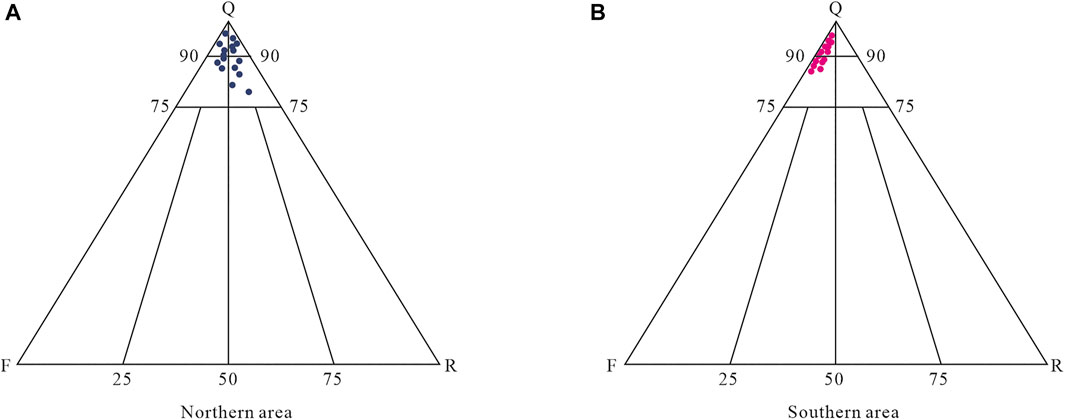
FIGURE 4. Constituents of the Xiaoheba Formation sandstone types in the study area. (A) Northern, (B) Southern.
3.2 Physical Characteristics of Reservoir Samples and Types of Reservoir Space
3.2.1 Physical Characteristics of Reservoir Samples
Analysis was conducted on the physical characteristics of 286 reservoir samples collected from the outcrop sections of the Silurian Xiaoheba Formation in Southeast Sichuan. The results demonstrate that the Silurian Xiaoheba Formation reservoir features a porosity distribution in the range of 0.04%∼8.67%, with the average value of 2.80%, and a permeability distribution in the range of 0.001∼0.923 × 10–3 μm2, with the average value of 0.028 × 10–3 μm2, and thus is a low porosity and permeability reservoir. Statistics was carried out for the physical characteristics of the outcrop sections in the northern and southern parts of the study area, respectively. In the southern part, the porosity of the outcrop sections is relatively low, with the average of 1.98%, while the permeability is relatively high, with the average of 0.048 × 10–3 μm2, due to the strong compaction and the formation of a certain number of cracks. Meanwhile, in the northern part, the outcrop sections of Shuangliuba and Lengshuixi have higher porosity, with an average of 3.22%, while the permeability is lower, with an average of 0.021 × 10–3 μm2 (Table 1), due to the development of a large number of micropores, which have small diameters but are large in numbers, making more contributions to the reservoir porosity but few contributions to the permeability due to the poor connectivity. The Silurian Xiaoheba Formation in Southeast Sichuan has a poor porosity-permeability correlation, with a low correlation coefficient, and its porosity-permeability relationship varies between the reservoirs in different areas. Generally, the porosity distribution range of the outcrop reservoirs in the northern part is larger than the one in the south, and thus the physical characteristics of the reservoirs in the north are superior to those in the south (Figure 5).

TABLE 1. Average physical characteristics of the Xiaoheba formation of different areas in Southeast Sichuan.

FIGURE 5. Porosity-permeability intersection diagram of the Xiaoheba formation of different areas in Southeast Sichuan. (A) Northern, (B) Southern.
3.2.2 Types of Reservoir Space
As indicated by the analysis on the casting thin sections and SEM, the reservoir space of various sections in Southeast Sichuan, especially the sandstone reservoirs of the Xiaoheba Formation in the northern area, is dominated by secondary pores and cracks. Since the Silurian Xiaoheba Formation in Southeast Sichuan underwent strong compaction integrally, most of the primary pores were filled with other minerals, with only a few of them unfilled (Figures 6A,B). The secondary pores include intergranular dissolved pores, moldic pores, dissolved pores of siderite and bioclast, and dissolved cracks (Figures 6C–F). The intragranular dissolved pores are formed mainly by dissolution of soluble particles like feldspar, and partially with dissolution marks of quartz particles. The morphology of the pores is generally irregular and mostly dissolution residual-like under SEM. The moldic pores are pore space formed by complete dissolution of clastic particles, mineral crystals, and organisms, with the original morphology of the particles preserved. Therefore, the moldic pores of the Silurian Xiaoheba Formation reservoirs in Southeast Sichuan are mostly formed by strong dissolution of feldspar and complete dissolution of clastic rocks.
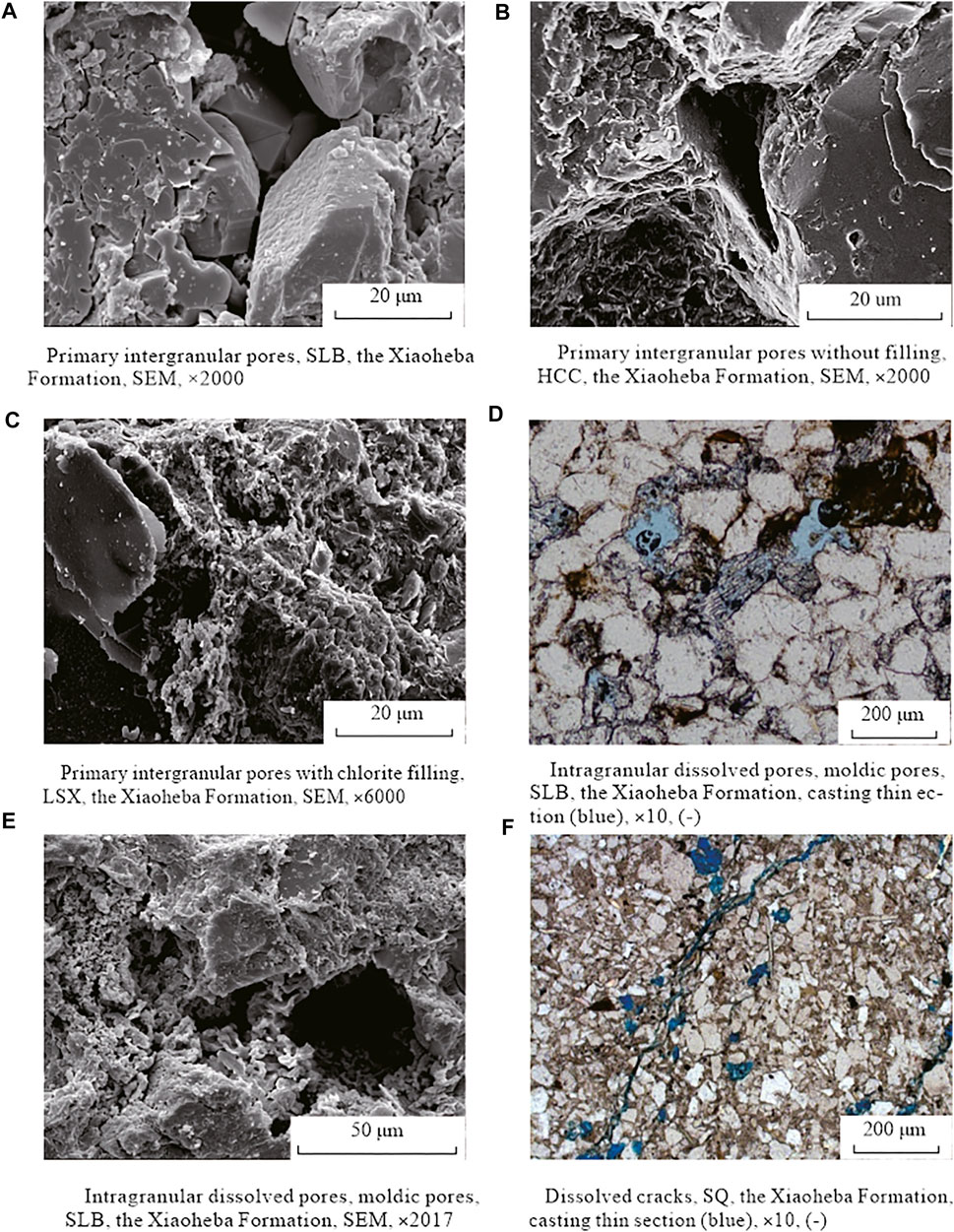
FIGURE 6. Pore types of the Silurian Xiaoheba Formation reservoirs in Southeast Sichuan. (A) Primary intergranular pores, SLB, the Xiaoheba Formation, SEM, ×2000; (B) Primary intergranular pores without filling, HCC, the Xiaoheba Formation, SEM, ×2000; (C) Feldspar dissolved pores, SLB, the Xiaoheba Formation, SEM, ×2000; (D) Intragranular dissolved pores, moldic pores, SLB, the Xiaoheba Formation, casting thin section (blue), ×10, (−); (E) Intragranular dissolved pores, moldic pores, SLB, the Xiaoheba Formation, SEM, ×2000; (F) Dissolved cracks, SQ, the Xiaoheba Formation, casting thin section (blue), ×10, (−)
4 Reservoir Diagenesis Features
4.1 Compaction
Compaction existed in the whole diagenetic evolution process of the Xiaoheba Formation reservoirs in different areas of Southeast Sichuan. The twisting and deformation of the plastic constituents like mica caused by compaction can be observed under microscope, and so is the intergranular filling of clay minerals and mica debris, which show a phenomenon of directional distribution among the particles (Figure 7A). With the increase of depth, the contact between the clastic particles changes gradually from point contact to line contact, while the contact of the clastic particles under intense compaction is line contact—concavo-convex contact (Figure 7B). Meanwhile, brittle particles including quartz and feldspar under compaction will be broken along the weak plane or at the contact between particles and then form pressed cracks.
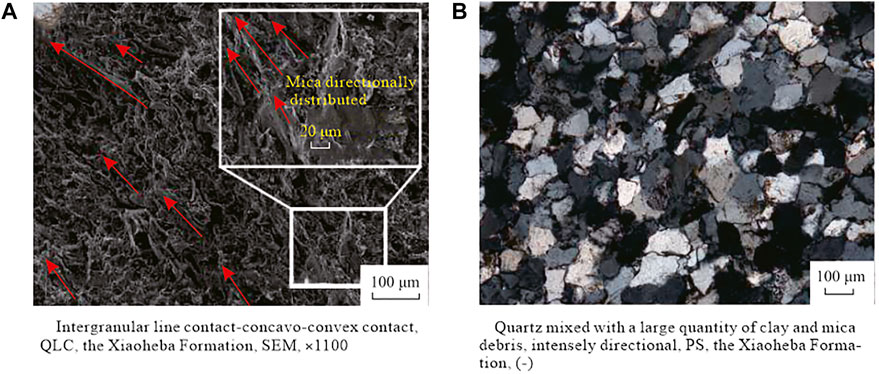
FIGURE 7. Typical thin sections of the Xiaoheba Formation under compaction in Southeast Sichuan. (A) Mica directionally distributed, SQ, the Xiaoheba Formation, SEM, ×150; (B) Intergranular line contact—concavo-convex contact, PS, the Xiaoheba Formation, (+)
Based on the test data of particle size analysis, taking the northern area of the study area as an example, according to Scherer’s original porosity recovery formula (Scherer, 1987), the average original porosity of its sandstone is 36.1% and the post-compaction average porosity is 9.40%, with the porosity reduction by compaction deemed as 73%, indicating that the reservoirs have been affected by intense compaction.
4.2 Cementation
The main types of cementation in the sandstone reservoirs of the Silurian Xiaoheba Formation in Southeast Sichuan include carbonate cementation and siliceous cement, associated with clay minerals and authigenic feldspar cement both in small numbers, but the cement types and characteristics in the northern part of this study area are different from those in the south. The carbonate cementation of the sandstone reservoirs in the Silurian Xiaoheba Formation in Southeast Sichuan is dominated by calcite, with siderite generally included at the same time. Within the study area, the southern part close to the carbonate rock platforms has higher content of calcite cement, while the northern part far from the carbonate rock platforms has extremely low content of calcite cement. Meanwhile, siderite cement is low in content in the formations of the southern part, but relatively common in the northern one. It indicates that formation fluids in the sedimentary stage of the southern part close to the carbonate rock platforms are rich in Ca2+ and tend to generate calcite cement, resulting in intense calcite cementation and tight reservoirs in the Xiaoheba Formation of the southern part, while the northern part far from the carbonate rock platform is relatively short of Ca2+, and thus generates siderite cement with CO32- and Fe2+.
The calcite cement in the reservoirs of the southern part is mainly porous cement or basal cement (Figure 8A), fills the space between the particles, and plugs the pores with a large quantity, making the reservoirs tight. Meanwhile, the calcite cement in the northern part is quite low in content, and occasionally shows scattered distribution of tiny-dotted calcite under cathodoluminescence (CL) (Figure 8B). Under SEM, it can be seen that part of the dissolved pores has an extremely low quantity of microcrystalline calcite and none are plugged by calcite cement, with all dissolved pores preserved in a good condition. The reservoirs in the northern area have residual calcite dissolution according to SEM (Figure 8C), indicating that although first calcite cementation existed in the northern area before the dissolution occurred, it became extremely rare or even disappeared after the dissolution. Siderite is distributed among the particles in a scattered way with the morphology of euhedral—subhedral rhomb particles, and silty crystalline siderites are also seen growing along particle rims. The siderite in the formations has been mostly turned into limonite by oxidation or moldic pores by dissolution, well preserving the crystal form of the particles (Figure 8D).
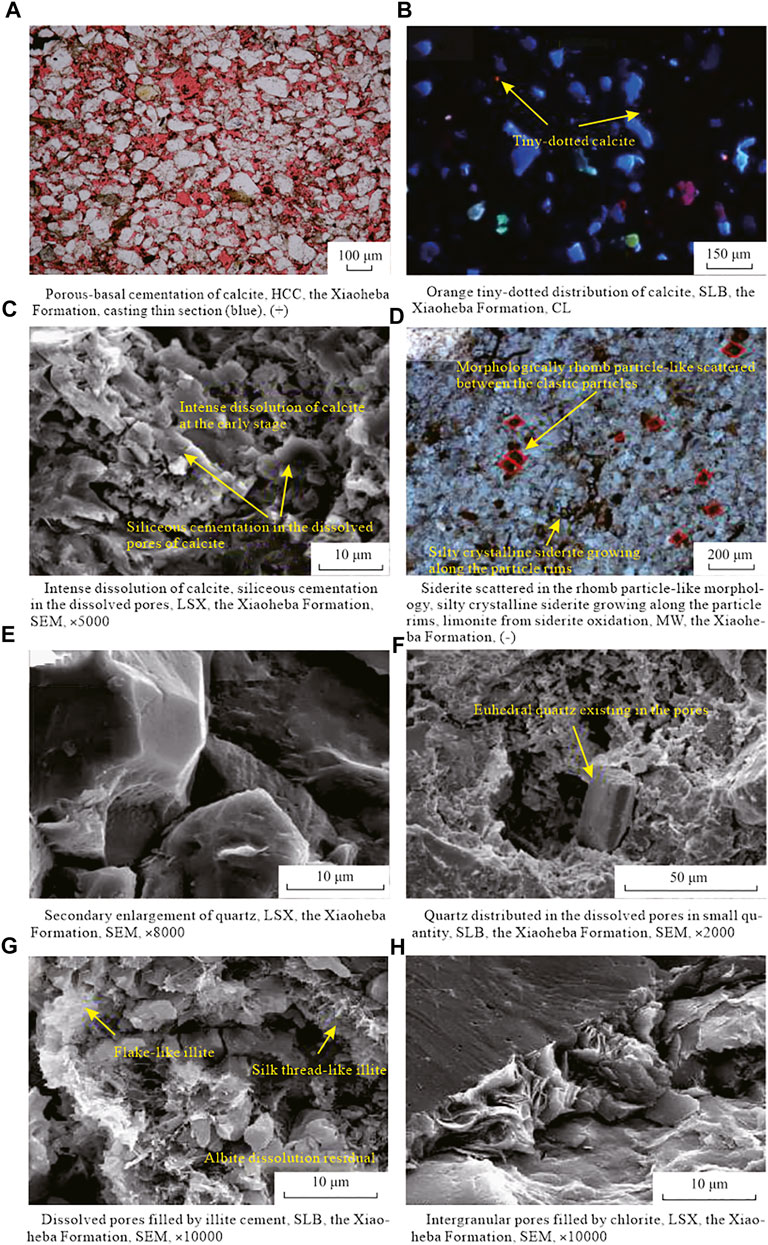
FIGURE 8. Types and features of carbonate cementation of the Xiaoheba Formation reservoirs in Southeast Sichuan, (A) Porous-basal cementation of calcite, HCC, the Xiaoheba Formation, casting thin section (blue), (+); (B) Orange tiny-dotted distribution of calcite, SLB, the Xiaoheba Formation, CL; (C) Intense dissolution of calcite, siliceous cementation in the dissolved pores, LSX, the Xiaoheba Formation, SEM, ×5000; (D) Siderite scattered in the rhomb particle-like morphology, silty crystalline siderite growing along the particle rims, limonite from siderite oxidation, MW, the Xiaoheba Formation, (−); (E) Secondary enlargement of quartz, LSX, the Xiaoheba Formation, SEM, ×8000; (F) Quartz distributed in the dissolved pores in small quantity, SLB, the Xiaoheba Formation, SEM, ×2000; (G) Dissolved pores filled by illite cement, SLB, the Xiaoheba Formation, SEM, ×10000; (H) Intergranular pores filled by chlorite, LSX, the Xiaoheba Formation, SEM, ×10000.
According to the thin section observation, the siliceous cementation in the sandstone reservoirs of the Silurian Xiaoheba Formation in Southeast Sichuan mainly features the secondary enlargement of quartz and pore filling (Figures 8E,F). Besides, most of the siliceous cement is developed along the rims of clastic quartz particles but is generally low in content. Since the siliceous cement content is higher in the northern part than in the southern part, it was inferred that the formation of a large quantity of calcite cement in the southern part relatively inhibited the formation of siliceous cement, while calcite cement was rarely developed in the northern part and thus siliceous cement was more developed instead.
Samples with obvious cementation were collected from the northern area using the inversion method, and the porosity recovery calculation based on the Borad and Wey’s (Yuan et al., 2017) empirical statistical formula was conducted. According to the calculation results, the porosity of the Xiaoheba Formation reservoirs in the northern area was reduced by about 13.04% due to the siliceous cementation, and further reduced by 5.3% due to the carbonate cementation, indicating that the carbonate cementation in the reservoirs of the north was relatively weak.
The content of authigenic clay minerals in the reservoirs is low, while the clay matrix accounts for the greatest proportion, with illite, illite-montmorillonite mixed-layer, and chlorite as the main types of clay minerals. The illite is mostly scaly or silk thread-like in morphology and fills up the intergranular or intragranular dissolved pores (Figure 8G), while the chlorite is pompon-like or flake-like and fills up the intergranular or intragranular dissolved pores (Figure 8H). Besides, micropores can be seen between the illite and chlorite sections under SEM. Among them, illite has a destructive effect on the reservoirs by reducing the pore connectivity and permeability.
4.3 Dissolution
Dissolution, as the constructive diagenesis for the reservoir characteristics of the Xiaoheba Formation in Southeast Sichuan, mainly features different dissolution degrees of clastic constituents. According to microscopy and SEM, the Xiaoheba Formation dissolution mainly occurred to siltstone and extremely fine sandstone in the early—medium diagenetic stage and supergene stage of the diagenesis process. The dissolving fluids are mainly organic acids and carbon dioxide, while the dissolved constituents also include calcareous cement.
Feldspar particle dissolution and early-stage calcite cement dissolution can be seen under a microscope, and siderite dissolution is relatively common in the northern part of the study area. Regarding feldspar dissolution, there are two types, of which one is the dissolution at the feldspar rim, forming intergranular dissolved pores, and the other occurs inside feldspar, mostly occurring along the cleavage cracks and forming honeycomb intragranular dissolved pores and even moldic pores. Some of the feldspar dissolved pores are isolated and others are connected with each other (Figure 9A). The dissolution of calcite mainly features the dissolution of interstitial materials in part of sand mass, especially in the samples from the northern area, which show the residual of calcite dissolution under a microscope. Besides, some of the calcite dissolution pores show the siliceous constituent and albite cemented in the late stage, indicating that calcite cementationoccurred to the Xiaoheba Formation reservoirs once in the northern area in the early stage, and then the calcite was dissolved during diagenesis. The siderite was mostly turned into moldic pores by dissolution (Figure 9B), or limonite by oxidation. The dissolution phenomena as mentioned above demonstrate that the Xiaoheba Formation in the northern part of the study area has undergone relatively intense dissolution and diagenesis.
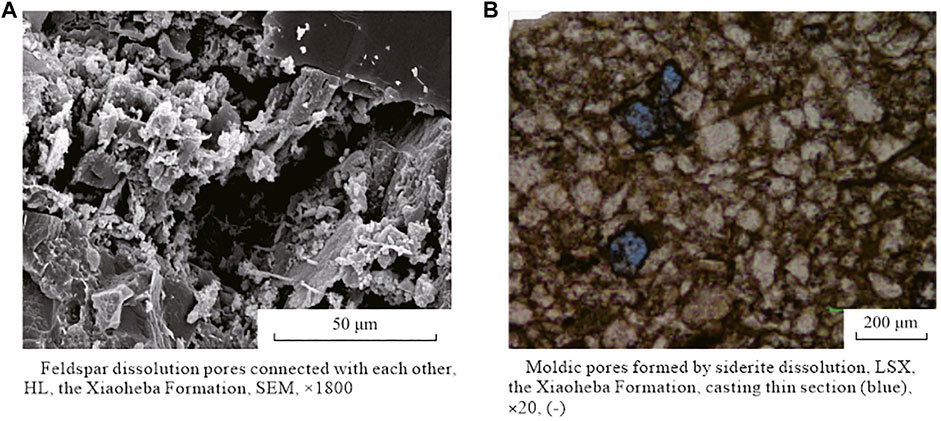
FIGURE 9. Types and features of dissolution in the Xiaoheba Formation reservoirs in Southeast Sichuan; (A) Feldspar dissolution pores connected with each other, HL, the Xiaoheba Formation, SEM, ×1800; (B) Moldic pores formed by siderite dissolution, LSX, the Xiaoheba Formation, casting thin section (blue), ×20, (−).
The porosity of the reservoirs increased after dissolution basically equals the dissolved secondary pores preserved to date. According to the calculation, the porosity of the Xiaoheba Formation in the northern area was increased by 4.8% or so by dissolution, effectively improving the physical characteristics of the reservoirs. The post-dissolution average porosity was about 5.92%, close to the porosity at present.
5 Evolution of Reservoir Diagenesis
5.1 Diagenetic Stage Classification
Based on the systematic research in the diagenesis features of the Xiaoheba Formation in Southeast Sichuan in combination with the diagenetic stage classification in Oil and Natural Gas Industry Standard of the People’s Republic of China (SY/T 5477—2003) and the paleogeotemperature restoration, with the clay mineral combination, illite-montmorillonite mixed-layer ratio (I/S value), characteristics of authigenic minerals, and vitrinite reflectance (Ro) as the main basis, this paper classified the diagenetic stages of the reservoirs in different parts of the Xiaoheba Formation in Southeast Sichuan.
The main clay minerals in the sandstone reservoirs of the Xiaoheba Formation in the northern area are illite and chlorite, with the content of 45–55% and 20–32%, respectively, and the average content of 50.8% and 20.2%, respectively, followed by kaolinite, with the content of 8–22% and the average content of 15.6%. The chlorite-smectite mixed layer has basically disappeared, while the illite-montmorillonite mixed-layer exists in content at 6–13%, with an average of 8.2% (Figure 10A). The Ro value is high, with the MIN value at 2.2% and the MAX value at 3.13%, and the average value at 2.65%, and thus the thermal evolution is in the over-mature stage. The secondary enlargement margin of quartz has been extensively developed and features a large width. When measuring the homogenization temperature of the brine inclusion in the siliceous cement of various samples, it found that the inclusion homogenization temperature featured double peaks (Figure 11A), indicating that two phases of massive quartz enlargement have occurred during Periods A and B of the medium diagenetic stage. It illustrates that the diagenetic evolution of the Xiaoheba Formation reservoir in the northern area has reached the late diagenetic stage (Figure 12A).
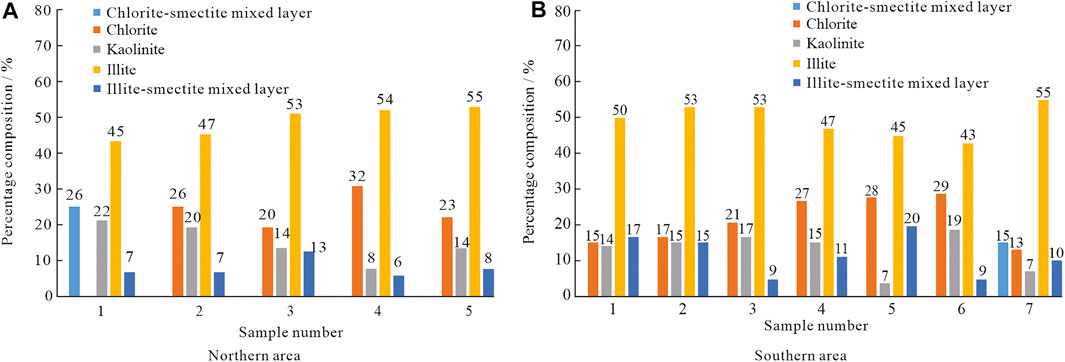
FIGURE 10. Relative content percentage of clay minerals in the Xiaoheba Formation; (A) Northern; (B) Southern.

FIGURE 11. Histogram of aqueous inclusion homogenization temperature of the Xiaoheba Formation; (A) Northern; (B) Southern.
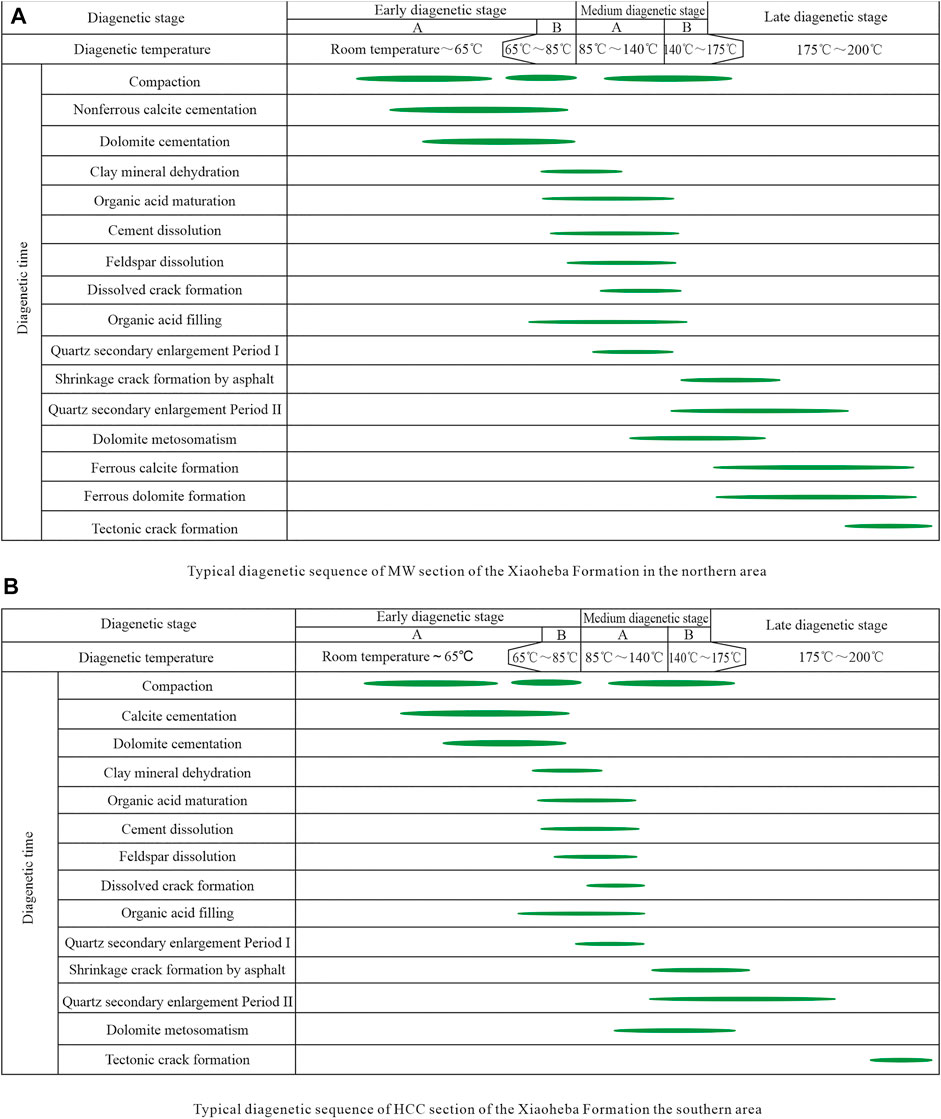
FIGURE 12. Diagenetic stage classification of the Xiaoheba Formation in Southeast Sichuan; (A) Typical diagenetic sequence of the MW section of the Xiaoheba Formation in the northern area; (B) Typical diagenetic sequence of the HCC section of the Xiaoheba Formation the southern area
The main clay minerals in the sandstone reservoirs of the Xiaoheba Formation in the southern area are illite, with the average content of 48.5%, followed by chlorite, with the average content of 20.0%. Besides, the illite-montmorillonite mixed-layer ratio (I/S value) is about 15.6%, and the mixed layer is located in the ordered mixed layer of illite/montmorillonite, with illite + illite-montmorillonite mixed-layer + chlorite as the common clay mineral combination (Figure 10B). The vitrinite reflectance is generally higher than 1.7%, and therefore the thermal evolution is in the over-mature stage. According to the measurement of the fluid inclusion temperature, the homogenization temperature of fluid inclusion inside the secondary enlargement margin of quartz has two peak values, i.e., 120°C–130°C and 140°C–150°C, respectively, representing that the secondary enlargement has occurred twice (Figure 11B). The pores in the sandstone are dominated by secondary pores and cracks, of which most are filled with calcite or asphalt. It illustrates that the sandstone of the Xiaoheba Formation in the southern area has reached Period B of the medium diagenetic stage—the early stage of the late diagenetic stage (Figure 12B).
5.2 Diagenetic Evolution Process
In the early diagenetic stage, the Xiaoheba Formation in Southeast Sichuan had its stratum depth continuously increasing, and had its original porosity quickly decreased by compaction, which severely damaged the primary pores. Meanwhile, the carbonate cement including calcite and siderite began to deposit. The dissolution of calcite and siderite in the early stage can be observed through thin section authentication and SEM, while the early-stage carbonate cement resisted the compaction and the formation of quartz secondary enlargement to some extent, conducive to the preservation of the reservoir pores. In the medium diagenetic stage, when the dissolution mainly occurred, the organic acids generated after the maturation of the source rocks in the underlying Longmaxi Formation entered the strata in large numbers, dissolving feldspar and carbonate cement, and producing a great number of secondary dissolved pores. The dissolution in the Xiaoheba Formation reservoirs in the northern area was relatively intense, showing bay-like or honeycomb particle rims and insides caused by dissolution and also the asphalt inclusion on residual orthoclase, which indicated that the reservoirs had been reformed by dissolution of the organic acids related to the oil and gas generation in the early—medium diagenetic stage. In the late diagenetic stage, the diagenesis was dominated by cementation, with a difference between the northern and southern areas. Since the calcite cement occupied the space in the dissolved pores, the pores were sharply reduced, making it unfavorable for reservoir development. The siliceous cement, mostly existing in the form of quartz secondary enlargement, filled up part of the original pores, and was relatively hard to dissolve at the same time, also damaging the reservoirs. Nano-scale and micron-scale micropores were extensively distributed in the clay minerals, making certain contributions to the physical characteristics of the reservoirs. In the southern area, the cementation was dominated by calcite cementation and formed tight caliche, and thus the calcite cementation was the main reason for the deterioration of the physical characteristics of the reservoirs. Meanwhile, in the northern area, the cementation was dominated by quartz secondary enlargement, which extensively occurred but was underdeveloped, with low content. It can be observed through thin section authentication and SEM that most of the dissolved pores have not been plugged by cement that was generated later, thus the reservoir pores are well preserved.
6 Discussion
6.1 Sedimentary Facies—Physical Characteristic Relationship in Different Parts of the Study Area
The sediment of the Xiaoheba Formation in the study area is generally fine, and the sedimentary microfacies have relatively weak control on the reservoirs, but inhomogeneity exists between different microfacies. The Xiaoheba Formation in the northern area of the study area has mainly developed the sedimentary microfacies of the underwater distributary main channel of the distal shallow-water delta front. The sediment here has relatively coarse particle sizes, and is dominated by medium-bedded—thick-bedded fine-grained quartz sandstone and siltstone, which are interbedded with thin-bedded mudstone, and locally distributed with pebbly fine sandstone, with low content of interstitial materials. Through the observation of a lot of thin sections, it was found that, in the sandstone-mudstone interbedded reservoir, the effective pores were mainly developed in the fine sandstone and coarse siltstone with higher thickness and coarser particle sizes, and that the porosity would go up with the increase of both the sand body thickness and the particle size (Figure 13A). Additionally, it is easier for the lithological combination of medium-bedded—thick-bedded sandstone + thin-bedded mudstone to form cracks and thereafter connect the reservoirs to each other (Figures 14A–C). Therefore, the porosity and permeability of the medium-bedded—thick-bedded fine sandstone reservoirs in the sedimentation of the underwater distributary main channel microfacies in the northern area are best (Figure 13B), with large crack opening, good connectivity, and tendency to form favorable reservoirs.

FIGURE 13. Relationship of physical characteristics respectively with lithology and sedimentary microfacies of the Xiaoheba Formation in the northern area; (A) Relationship between lithology and physical characteristics; (B) Relationship between sedimentary microfacies and physical characteristics
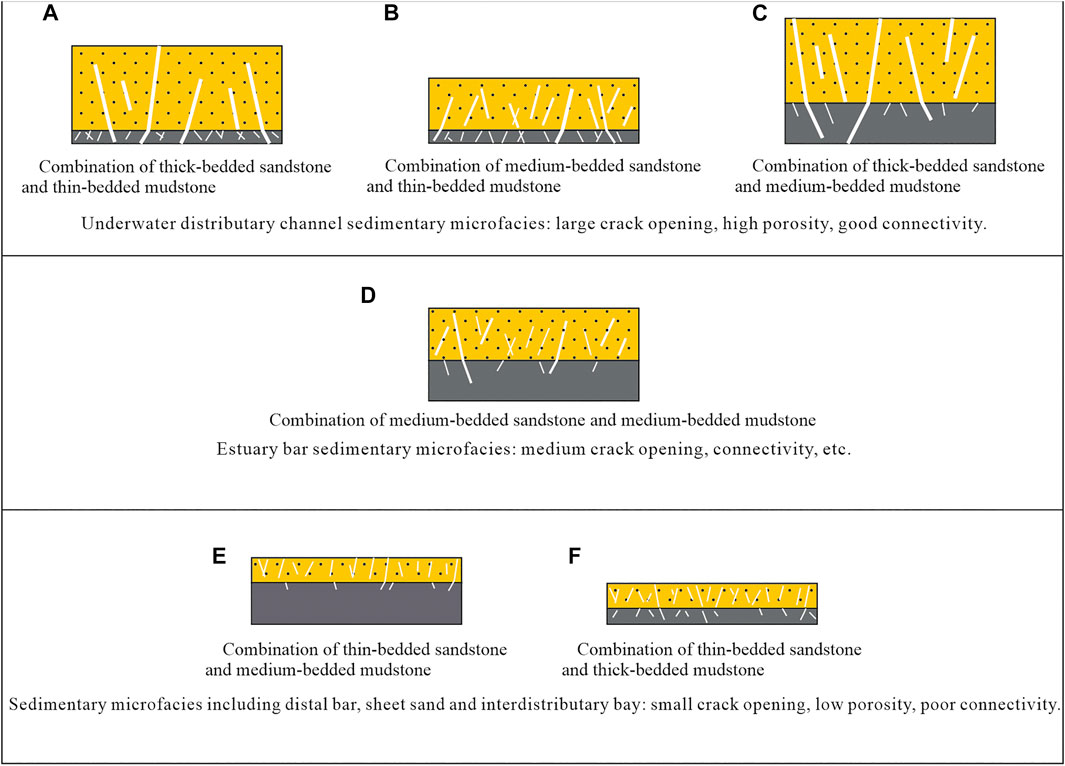
FIGURE 14. Schematic of reservoir crack development models of the lithological combinations corresponding to various sedimentary microfacies.
The Xiaoheba Formation in the southern area of the study area has mainly developed the sedimentary microfacies of an estuary bar, sheet sand, distal bar, and interdistributary bay of the distal shallow-water delta, which are far from the main channel and weak in hydrodynamic power. The sediment has fine particle sizes and is dominated by medium-bedded—thin-bedded siltstone and argillaceous siltstone, with higher content of interstitial materials than that of the sand bodies in the underwater distributary channel, and underdeveloped effective pores. Further, the lithological combination of medium-bedded—thin-bedded sandstone + relatively thick-bedded mudstone of the Xiaoheba Formation in the southern area features small crack opening, low porosity, and poor connectivity (Figures 14D–F). Therefore, the reservoirs in the southern area feature poorer physical characteristics than those in the northern area, and are tight reservoirs with low porosity and permeability.
6.2 Diagenesis and Physical Characteristics in Different Regions of the Study Area
The diagenesis process of the Xiaoheba Formation reservoirs in the northern area of the study area can be summarized as four major stages: compaction—early-stage weak cementation of calcite—intense dissolution—late-stage weak cementation of quartz secondary enlargement. According to the statistics of the apparent compaction rates and porosity of the sandstone samples from the study area and the intersection diagram of apparent compaction rate—porosity (Figure 15A), the compaction of the Xiaoheba Formation in the study area is generally medium, and has caused the original porosity to decrease rapidly and severely damaged the primary pores in the initial stage of deep burial. Under the influence of the compaction, the sandstone volume shrank, while the reservoirs became tight and had their physical characteristics deteriorated since the original intergranular pores continuously disappeared. In the early burial stage, since the carbonate platform was far away, the carbonate cementation was weak and plugged a few primary sandstone pores. Therefore, the influence of carbonate cement on the reservoirs was mainly destructive, with a large number of primary pores preserved due to the low content of carbonate cement. Cementation can further reduce the number of pores, but the pore reduction caused by cementation is reversible compared to that caused by compaction. Carbonate cementation can be dissolved under acidic conditions, while siliceous cementation can be dissolved under alkaline conditions, and they both then produce secondary pores, degrading the tightness of the reservoirs to some extent. Dissolution is a kind of ameliorative diagenesis and the apparent dissolution intensity is positively correlated with the porosity to some extent based on the projected point figure of them (Figure 15B). The dissolution of the Xiaoheba Formation in the northern area mainly occurred in feldspar, carbonate cement, and the inside of clastic particles, forming many dissolved pores that achieved certain improvement of the physical characteristics of the reservoirs. Moreover, the higher the intergranular dissolution intensity, the higher the porosity and the better the corresponding reservoir characteristics. In the reservoirs in the northern area, the siliceous cementation in the late diagenetic stage was relatively weak and mostly existed in the pores in the way of quartz secondary enlargement, but its destructive effect on the physical characteristics of the reservoirs is negligible due to its low content.
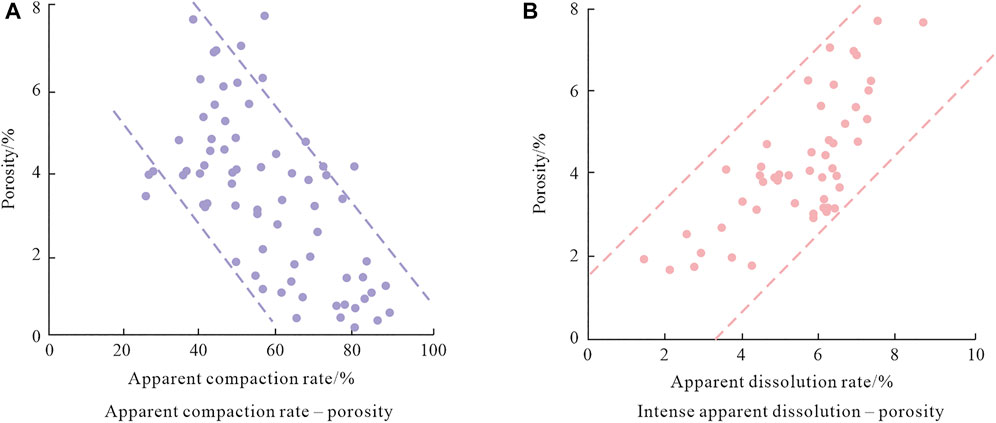
FIGURE 15. Relationship between diagenesis parameters and reservoir porosity of the Xiaoheba Formation in the northern area; (A) Apparent compaction rate—porosity; (B) Intense apparent dissolution—porosity.
The diagenesis process of the Xiaoheba Formation reservoirs in the southern area of the study area can be summarized as four major stages: compaction—early-stage intense cementation of calcite—weak dissolution—late-stage intense cementation of calcite. According to thin section observation under a microscope, the compaction of the Xiaoheba Formation reservoirs in the southern area is to a medium—intense degree mainly because the mineral particles are directionally arranged after compaction, and mica particles, at the same time, are bent and deformed in the setting of sedimentary compaction and intense tectonic compression, with the intergranular contact changing from point contact to line contact or even concavo-convex contact. The diagenesis process in the northern and southern areas of the study area is different from each other mainly in the types of cement and the development degree of cementation, which are also the main reasons for the difference in the physical characteristics between the reservoirs in the northern and southern areas. The Xiaoheba Formation in the southern area has significant carbonate cementation in the lower part and significant siliceous cementation in the upper part. Since it is close to the carbonate platform, the calcite cementation was intense in the early burial stage, with cement plugging primary sandstone pores, forming tight caliche, and reducing the reservoir porosity. According to the projected point figures of porosity and the apparent carbonate cementation rate and apparent siliceous cementation rate drawn by taking the points with the porosity > 1%, the porosity generally decreases with the increase of apparent carbonate and siliceous cementation rates and content (Figures 16A,B). Meanwhile, the Xiaoheba Formation reservoirs in the southern area make it difficult acidic fluids to enter due to the intense carbonate cementation, and thus have weaker dissolution than the reservoirs in the northern area, which are mainly concentrated in the layers with particle mass enrichment and high feldspar content. The dissolved pores in the layers with the development of particle mass enrichment are mostly intergranular dissolved pores that are further formed on the basis of primary intergranular pores, while the dissolved pores in the layers with high feldspar content are mainly intragranular dissolved pores formed by dissolution of unstable constituents including feldspar, generally featuring poor reservoir characteristics. In addition to the influence of the carbonate platform in the late diagenetic stage, the calcite cementation was intense, leading to further deterioration of the physical characteristics of the reservoirs and the formation of tight sandstone reservoirs.
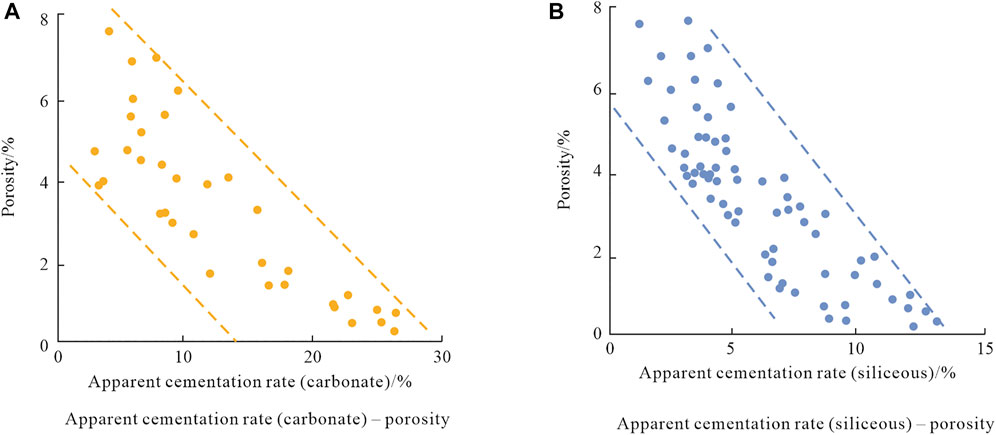
FIGURE 16. Relationship between diagenesis parameters and reservoir porosity of the Xiaoheba Formation in the southern area; (A) Apparent cementation rate (carbonate)—porosity; (B) Apparent cementation rate (siliceous)—porosity
6.3 Inhomogeneous Sedimentation—Diagenesis—Reservoir Formation Mode
The sandstone type, which is controlled by the nature of the parent rock, as well as transport and deposition, together with lithological constituent characteristics, have influence over the types and characteristics of water-rock reaction products and the evolution of the diagenetic pore (Gong et al., 2003; Xiao et al., 2003; Su et al., 2006; Yu et al., 2007; Yuan et al., 2007; Wood, 2013; Wan et al., 2014; Zheng and Liu, 2015), which in turn has an impact on the reservoir properties. With the research above, combined with the regional geological research achievements, the inhomogeneous sedimentation—diagenesis—reservoir formation mode for the Xiaoheba Formation in the northern and southern areas of Southeast Sichuan was established (Figure 17).
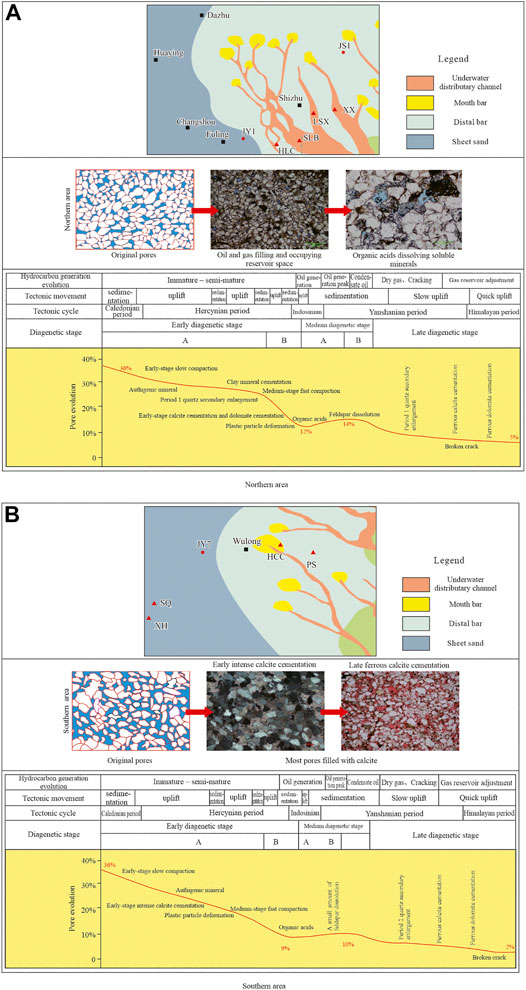
FIGURE 17. Inhomogeneous sedimentation—diagenesis—reservoir formation mode of the Xiaoheba Formation in Southeast Sichuan; (A) Northern area; (B) Southern area.
6.3.1 Northern Area
In the sedimentation period of the Xiaoheba Formation, the provenance of Xuefeng Mountain in Southeast Sichuan were transported to and unloaded in the dominant accommodation space in the Sichuan Basin along the gentle-slope ravines from southeast to northwest, and then formed the thick-bedded sandstone sedimentation of the underwater distributary main channel of the distal shallow-water delta front in the northern part of the study area, with good original physical characteristics of the reservoirs. From the contemporaneous period to early Period A of the early diagenetic stage, the rocks were weakly consolidated—semi-consolidated, producing mechanical compaction, which reached its peak in Period B of the early diagenetic stage. With the continuous increase of the sedimentation burial depth, the sediment began to enter the medium diagenetic stage, in which the organic matter in the underlying Longmaxi Formation gradually entered the maturation stage, with strongly acidic pore fluid. The most important diagenesis at this stage was the dissolution of early-stage calcite cementation and feldspar, which produced a certain number of dissolved pores. Meanwhile, the feldspar dissolution and the organic acids from source rocks provided a great number of siliceous sources for the quartz secondary enlargement, and quartz began growing spontaneously in part of the remaining intergranular pores until the late diagenetic stage. When the late diagenetic stage began, since the acid discharge capacity of the organic matter began to descend, the pH value of the pore water gradually increased and became alkalescent, while ferrocalcite and ankerite started to deposit, occupying most of the primary and secondary pores. At the same time, due to the tectonic effect, the Silurian strata in the study area began to rise, producing a certain number of broken cracks, which had some improvement effect on the reservoir permeability but contributed little to the porosity. Therefore, the Xiaoheba Formation in the north is a delta front main channel—acidic dissolution—relatively high porosity-permeability reservoir (Figure 17A).
6.3.2 Southern Area
In the sedimentation period of the Xiaoheba Formation, the southern area of the study area experienced the interactive development of thin-bedded sandstone, argillaceous siltstone, and mudstone. As a result, underwater distributary channel, sheet sand, and distal bar deposition formed in the distal shallow-water delta front that were far from the main channel. These deposits have relatively fine particle size and high shale content, thus serving as the material basis for the tight reservoirs in this area. The Xiaoheba Formation reservoirs in this area also underwent intense compaction. Additionally, since they are close to the carbonate platform and have sufficient calcareous sources, the carbonate cement like calcite cement began to sediment as early as in Periods A and B in the early diagenetic stage with the increase of the rock burial depth and the variation of the diagenetic environment, and filled up most of the residual primary space. The formation of calcite cement in a large amount lasted even up to the late diagenetic stage and finally plugged a great deal of pore space. Meanwhile, the intense carbonate cementation made it hard for acidic fluid to enter the reservoirs, leading to insufficient dissolution. Generally speaking, the Xiaoheba Formation in this area is a delta front distal bar/sheet sand—carbonate cementation—low porosity-permeability reservoir (Figure 17B).
7 Conclusion
1) In the sedimentation period of the Xiaoheba Formation in Southeast Sichuan, the provenance of Xuefeng Mountain was transported to and discharged in the dominant accommodation space in the Sichuan Basin along the gentle-slope ravines from southeast to northwest, and then formed the sedimentary microfacies of the underwater distributary main channel of the distal shallow-water delta front in the northern part of the study area, while forming the microfacies of an estuary bar, sheet sand, distal bar, and interdistributary bay in the southern area. The physical characteristics of the sandstone are positively correlated with the thickness and particle sizes. The microfacies sandstone of the underwater distributary main channel dominated by medium-bedded—thick-bedded sandstone has high porosity, large crack opening, and good connectivity, followed by the microfacies sandstone of an estuary bar with medium-bedded sandstone interbedded with mudstone featuring medium porosity, crack opening, and connectivity. Meanwhile, the microfacies of distal bar and sheet sand correspond to the sandstone reservoirs with high mudstone content, low porosity, and poor connectivity.
2) The Xiaoheba Formation in the study area is generally in the late diagenetic stage, and has main reservoir space types including various kinds of dissolved pores, micro-cracks, and pore-crack reservoir space systems, with evident inhomogeneity in the diagenetic evolution between the northern and southern areas.
3) The difference in the diagenesis process between the northern and southern parts of the study area is mainly reflected in the cement types and development degree, which are the main reasons for the inhomogeneity of physical characteristics between the reservoirs in the two areas. For the northern part, the geological conditions for the formation of relatively superior reservoirs are better, and acidic dissolution plays a major role in the improvement of the physical characteristics of the reservoirs. In addition, since the northern area is far from the carbonate platform, soluble minerals including early-stage cement and feldspar have formed pore space through the reformation by dissolution. Besides, the late-stage cementation is dominated by quartz secondary enlargement in a small amount. Therefore, the dissolved pores are well preserved, with relatively good physical characteristics. However, the southern area is close to the carbonate platform and has a great amount of calcite formed in the early and late diagenetic stages both due to the sufficient calcareous sources, resulting in plugged pores, tight reservoirs, and poor physical characteristics.
4) The Xiaoheba Formation in the study area features two different sedimentation—diagenesis—reservoir formation modes, namely being the northern area—delta front main channel—acidic dissolution—relatively high porosity-permeability reservoirs, and the southern area—delta front distal bar/sheet sand—carbonate cementation—low porosity-permeability reservoirs.
Data Availability Statement
The original contributions presented in the study are included in the article/Supplementary Material, further inquiries can be directed to the corresponding author.
Author Contributions
Authors have participated in all the research works in this paper. CL was responsible for the study of sedimentary reservoir and experimental analysis.
Conflict of Interest
The author declares that the research was conducted in the absence of any commercial or financial relationships that could be construed as a potential conflict of interest.
Publisher’s Note
All claims expressed in this article are solely those of the authors and do not necessarily represent those of their affiliated organizations, or those of the publisher, the editors and the reviewers. Any product that may be evaluated in this article, or claim that may be made by its manufacturer, is not guaranteed or endorsed by the publisher.
References
Ajdukiewicz, J. M., and Lander, R. H. (2010). Sandstone Reservoir Quality Prediction: The State of the Art. Bulletin 94 (8), 1083–1091. doi:10.1306/intro060110
Ali, S. A., Clark, W. J., and Moore, W. R. (2010). Diagenesis and Reservoir Quality[J]. Oilfield Rev. 22 (2), 14–27.
Bello, A. M., Jones, S., Gluyas, J., Acikalin, S., and Cartigny, M. (2021). Role Played by Clay Content in Controlling Reservoir Quality of Submarine Fan System, Forties Sandstone Member, Central Graben, North Sea. Mar. Petroleum Geol. 128, 105058. doi:10.1016/j.marpetgeo.2021.105058
Cao, G., Wang, X., and Zhu, X. (2016). Diagenetic Evolution of Es3x Nearshore Subaqueous Fan Reservoir and its Influence on Property in the Steep Slope Zone of Western Chezhen Sub-Sag[J]. Acta Sedimentol. Sin. 34 (1), 158–167.
Cao, T., Zhong, D., and Niu, S. (2020). Alkaline Diagenesis and Porosity Evolution of Zhuhai Formation Reservoirs in Eastern Huizhou Sag[J]. Acta Sedimentol. Sin. 38 (6), 1327–1337. doi:10.14027/j.issn.1000-0550.2020.011
Cao, Y., and Jiang, Z. (2002). Diagenesis-pool Forming Model of the Lower Member of Dongying Formation in the Eastern Slope Area of Chengdao, Bohai Bay Basin, China[J]. Mineralogy Petrology 22 (2), 64–68. doi:10.3969/j.issn.1001-6872.2002.02.014
Cao, Y., Tian, Y., and Song, M. (2018). Characteristics of Low-Permeability Clastic Reservoirs and Genesis of Relatively High-Quality Reservoirs in the Continental Rift Lake Basin: A Case Study of Paleogene in the Dongying Sag, Jiyang Depression[J]. Acta Pet. Sin. 39 (7), 727–743. doi:10.7623/syxb201807001
Cao, Y., Yan, M., and Xi, K. (2019). The Characteristics and Controlling Factors of Glutenite Reservoir in the Triassic Baikouquan Formation, Xiazijie Area, Mahu Depression[J]. Acta Sedimentol. Sin. 37 (5), 945–956. doi:10.14027/j.issn.1000-0550.2019.002
Feng, J., Gao, Z., and Cui, J. (2016). The Exploration Status and Research Advances of Deep and Ultra-deep Clastic Reservoirs[J]. Adv. Earth Sci. 31 (7), 718–736. doi:10.11867/j.issn.1001-8166.2016.07.0718
Gao, W., Li, X., and Zhang, G. (2018). The Relationship Research between Densification of Reservoir and Accumulation of the Deep Tight Sandstone Gas Reservoirs of the Kelasu Tectonic Zone in Kuqa Depression, Tarim Basin [J]. Nat. Gas. Geosci. 29 (2), 226–235. doi:10.11764/j.issn.1672-1926.2017.12.007
Gong, X., Shi, Z., Wang, Y., Tian, Y., Li, W., and Liu, L. (2017). Characteristics and Origin of the Relatively High-Quality Tight Reservoir in the Silurian Xiaoheba Formation in the Southeastern Sichuan Basin. Plos One 12 (7), e0180980–12. doi:10.1371/journal.pone.0180980
Gong, Y., Wang, L., and Liu, S. (2003). Distribution Characteristics of Geotemperature Field in Jiyang Depression, Shandong, North China[J]. Chin. J. Geophys. 46 (5), 652–658. doi:10.1002/cjg2.413
Haile, B. G., Klausen, T. G., Czarniecka, U., Xi, K., Jahren, J., and Hellevang, H. (2018). How Are Diagenesis and Reservoir Quality Linked to Depositional Facies? A Deltaic Succession, Edgeøya, Svalbard. Mar. Petroleum Geol. 92, 519–546. doi:10.1016/j.marpetgeo.2017.11.019
He, L., Tan, Q., and Wang, R. (2013). Sedimentary Facies, Sedimentary Model and Evolution of the Shiniulan Formation of Early Silurian in the Southeast Sichuan[J]. J. Mineralogy Petrology 33 (4), 96–106.
Higgs, K. E., Arnot, M. J., Browne, G. H., and Kennedy, E. M. (2010). Reservoir Potential of Late Cretaceous Terrestrial to Shallow Marine Sandstones, Taranaki Basin, New Zealand. Mar. Petroleum Geol. 27 (9), 1849–1871. doi:10.1016/j.marpetgeo.2010.08.002
Hou, M. C., Chen, H. D., and Chen, A. Q. (2010). Constraints of the Jiangnan-Xuefeng Upheaval to the Depositional System and Paleogeography Distribution of Southeast Sichuan-South Guizhou Depression during Shiniulan Period[J]. J. Chengdu Univ. Technol. Technol. Ed. 37 (4), 395–400. doi:10.3969/j.issn.1671-9727.2010.04.006
Hu, D. F., Wang, L. J., and Shi, Z. J. (2017). Study on the Formation Mechanism of High-Quality Reservoir of Xiaoheba Formation in Southeast Sichuan Basin, China[J]. J. Chengdu Univ. Technol. Technol. Ed. 44 (5), 543–552. doi:10.3969/j.issn.1671-9727.2017.05.05
Jia, J. H., and Zou, C. N. (2012). Reservoir and Oil-Gas Pool Characteristics of Paleozoic Marine Clastic Rocks in China[J]. Earth Sci. 37 (2), 57–66.
Khan, E. u., Saleem, M., Naseem, A. A., Ahmad, W., Yaseen, M., and Khan, T. U. (2020). Microfacies Analysis, Diagenetic Overprints, Geochemistry, and Reservoir Quality of the Jurassic Samanasuk Formation at the Kahi Section, Nizampur Basin, NW Himalayas, Pakistan. Carbonates Evaporites 35 (3), 95. doi:10.1007/s13146-020-00622-4
Li, B., Hu, B. W., and Shi, X. H. (2015). Study on the Silurian Sedimentary System of Western Hunan and the Formation Mode of Typical Foreland Basin[J]. Earth Sci. Front. 22 (6), 167–176. doi:10.13745/j.esf.2015.06.012
Li, L., Wei, J., Yin, H., Xie, J., Ding, Y., and Shi, S. (2018). Influence of Sedimentary Facies on Reservoir Quality and Distribution of Diagenetic Features in the Funing Formation, Wanglongzhuang Oilfield, Subei Basin, Eastern China. Arab. J. Geosci. 11 (15), 432. doi:10.1007/s12517-018-3745-6
Liu, Z., Shen, F., and Zhu, X. (2015). Progress of Shallow-Water Delta Research and a Case Study of Continental Lake Basin[J]. Oil&Gas Geol. 36 (4), 598–604. doi:10.11743/ogg20150409
Luo, J., Chi, L., and Lei, C. (2020). Discussion on Research Advances and Hot Issues in Diagenesis of Clastic-Rock Reservoirs[J]. J. Palaeogeogr. 22 (6), 1021–1040. doi:10.7605/gdlxb.2020.06.070
Mahmic, O., Dypvik, H., and Hammer, E. (2018). Diagenetic Influence on Reservoir Quality Evolution, Examples from Triassic Conglomerates/arenites in the Edvard Grieg Field, Norwegian North Sea. Mar. Petroleum Geol. 93, 247–271. doi:10.1016/j.marpetgeo.2018.03.006
Olsen, H., Briedis, N. A., and Renshaw, D. (2017). Sedimentological Analysis and Reservoir Characterization of a Multi-Darcy, Billion Barrel Oil Field - the Upper Jurassic Shallow Marine Sandstones of the Johan Sverdrup Field, North Sea, Norway. Mar. Petroleum Geol. 84, 102–134. doi:10.1016/j.marpetgeo.2017.03.029
Pan, R., Zhu, X., and Tan, M. (2018). Quantitative Research on Porosity Evolution of Deep Tight Reservoir in the Bashijiqike Formation in Kelasu Structure Zone, Kuqa Depression[J]. Earth Sci. Front. 25 (2), 159–169. doi:10.13745/j.esf.yx.2017-6-6
Qiu, Y. C., Luo, B., and Xia, M. L. (2019). Exploration Prospect and Potential:Marine Clastic Rocks of Silurian Xiaoheba Formation,Sichuan Basin[J]. Nat. Gas Explor. Dev. 42 (1), 1–7. doi:10.12055/gaskk.issn.1673-3177.2019.01.001
Scherer, M. (1987). Parameters Influencing Porosity in Sandstones: A Model for Sandstone Porosity Prediction[J]. AAPG Bull. 71 (5), 485–491. doi:10.1306/94886ed9-1704-11d7-8645000102c1865d
Shi, P., Gao, X., and Yang, P. (2009). Reservoir Quality and Controlling Factors of the Dongying Formation Sandstone Reservoirs in the Eastern Slope Zone of the Chengbei Low Uplift in the Bohai Bay[J]. Sediment. Geol. Tethyan Geol. 29 (3), 47–55. doi:10.3969/j.issn.1009-3850.2009.03.008
Su, X., Qiu, N., and Liu, Z. (2006). Tectonic-thermal Evolution of Zhanhua Sag[J]. J. Xi'an Shiyou Univ. Nat. Sci. Ed. 21 (3), 9–12. doi:10.3969/j.issn.1673-064X.2006.03.003
Tan, X., Huang, J., and Li, J. (2015). Origin of Carbonate Cements and the Transformation of the Reservoir in Sandstone under the Deep Burial Condition: A Case Study on Eocene Kongdian Formation in Jiyang Depression, Bohai Bay Basin[J]. Geol. Rev. 61 (5), 1107–1120. doi:10.16509/j.georeview.2015.05.013
Tan, X., Tian, R., and Luo, L. (2016). The “Sand-mud” Sedimentary Record and its Diagenetic System in Shore-Shallow Lacustrine: A Case Study of Eocene Kongdian Formation in Jiyang Depression[J]. Adv. Earth Sci. 31 (6), 615–633. doi:10.11867/j.issn.1001-8166.2016.06.0615
Taylor, T. R., Giles, M. R., Hathon, L. A., Diggs, T. N., Braunsdorf, N. R., Birbiglia, G. V., et al. (2010). Sandstone Diagenesis and Reservoir Quality Prediction: Models, Myths, and Reality. Bulletin 94 (8), 1093–1132. doi:10.1306/04211009123
Wan, Y., Ding, X., and Bai, X. (2014). Quartz Dissolution Causes and Influencing Factors in the Silurian Marine Clastic Reservoir Rocks in Central Tarim Basin[J]. Acta Sedimentol. Sin. 32 (1), 138–147.
Wang, G. R., Chen, H. D., and Zhu, Z. J. (2011). Characteristics and Geological Implications of Heavy Minerals in Lower Silurian Xiaoheba Formation Sandstones in Southeast Sichuan-West Hunan [J]. J. Chengdu Univ. Technol. Technol. Ed. 38 (1), 7–14. doi:10.3969/j.issn.1671-9727.2011.01.002
Wang, M., Xie, J., and Zhang, Q. (2019). Characteristics and Sedimentary Model of a Reticular Shallow-Water Delta with Distributary Channels: Lower Member of the Neogene Minghuazhen Formation in the Bozhong Area of the Huanghekou Sag, ChinaJ]. Arabian J. Geosciences 12 (24), 760–780. doi:10.1007/s12517-019-4580-0
Wang, Y., Shi, Z. J., and Liu, Y. W. (2011). Diagenesis of Tight Sandstone in the Silurian Xiaoheba Formation of the Shizhu Synclinorium, Western Hubei-Eastern Chongqing Area[J]. Oil Gas Geol. 32 (1), 75–82. doi:10.1007/s12182-011-0123-3
Wood, J. M. (2013). Water Distribution in the Montney Tight Gas Play of the Western Canadian Sedimentary Basin: Significance for Resource Evaluation[J]. SPE Reserv. Eval. Eng. 16 (3), 290–302. doi:10.2118/161824-pa
Wu, L., Guan, S., Ren, R., and Zhang, C. (2017). Sedimentary Evolution of Neoproterozoic Rift Basin in Northern Tarim. Petroleum Res. 2 (4), 315–323. doi:10.1016/j.ptlrs.2017.03.004
Xiao, H., Liu, Z., and Zhao, Y. (2003). Characteristics of Geotemperature and Geopressure Fields in the Jiyang Depression and Their Significance of Petroleum Geology[J]. Petroleum Explor. Dev. 30 (3), 68–70. doi:10.3321/j.issn:1000-0747.2003.03.019
Xie, T., Guo, H. Y., and Shen, Y. L. (2011). Diagenesis and Pore Evolution of Xiaoheba Formation Sandstone, Southeastern Sichuan Basin[J]. Nat. Gas Explor. Dev. 34 (3), 16–23.
Yang, Z. W., and Ji, F. (2009). The Characteristics of Sedimentary and Packing and Reserves Development for Silurian Basin in the East Chongqing and West Hubei Area[J]. J. Oil Gas Technol. 31 (4), 166–169. doi:10.3969/j.issn.1000-9752.2009.04.040
Yu, B., Lai, X., and Gao, Z. (2007). The Equilibrium between Calcite and Dolomite during Diagenesis in Sandstone Reservoir in Kela 2 Gas Field and the Influence to Quality of Reservoir[J]. Prog. Nat. Sci. 17 (3), 339–345.
Yuan, J., Li, X., and Ji, L. (2017). Tectonic-Diagenetic Evolution of Paleocene Tight Sandstone Reservoir Pores in the DN2 Gas Field of Kuqa Depression[J]. Acta Geol. Sin. 91 (9), 2065–2078.
Yuan, J., Zhang, S., and Qiao, J. (2007). Cause of Formation and Dynamic Mechanisms in Multiply Medium of Dissolved Pores in Deep Formation of Dongying Sag[J]. Acta Sedimentol. Sin. 25 (6), 840–846. doi:10.3969/j.issn.1000-0550.2007.06.004
Zhang, J. Y., Lu, Y. C., and Fu, X. Y. (2017). Sequence Stratigraphic Framework and Sedimentary Evolution of the Wufeng Formation the 1st Member of Longmaxi Formation in Fuling Area, Sichuan Basin[J]. Geol. Sci. Technol. Inf. 36 (4), 65–72.
Zhang, K., Jiang, S., and Zhao, R. (2022). Connectivity of Organic Matter Pores in the Lower Silurian Longmaxi Formation Shale, Sichuan Basin, Southern China: Analyses from Helium Ion Microscope and Focused Ion Beam Scanning Electron Microscope. Geol. J. 57, 1912–1924. doi:10.1002/gj.4387
Zhang, K., Peng, J., Wang, X., Jiang, Z., Song, Y., Jiang, L., et al. (2020). Effect of Organic Maturity on Shale Gas Genesis and Pores Development: A Case Study on Marine Shale in the Upper Yangtze Region, South China. Open Geosci. 12, 1617–1629. doi:10.1515/geo-2020-0216
Zhang, K., Song, Y., Jiang, Z., Xu, D., Li, L., Yuan, X., et al. (2022). Quantitative Comparison of Genesis and Pore Structure Characteristics of Siliceous Minerals in Marine Shale with Different TOC Contents-A Case Study on the Shale of Lower Silurian Longmaxi Formation in Sichuan Basin, Southern China. Front. Earth Sci. 10, 887160. doi:10.3389/feart.2022.887160
Zheng, Q., and Liu, Y. (2015). Diagenesis and Diagenetic Lithofacies of Tight Reservoir of Chang 4+5 Member of Yanchang Formation in Zhenbei, Ordos Basin[J]. Acta Sedimentol. Sin. 33 (5), 1000–1012. doi:10.14027/j.cnki.cjxb.2015.05.016
Zhou, P., Tang, Y., and Yin, H. (2017). Relationship between Characteristics of Fracture Belt and Production of Keshen 2 Gas Reservoir in Kelase Tectonic Zone, Tarim Basin [J]. Nat. Gas. Geosci. 28 (1), 135–145. doi:10.11764/j.issn.1672-1926.2016.11.028
Zhu, Z. J., and Chen, H. D. (2012). Sandstone Characteristics and Provenance Analysis of the Sandstone in Silurian Xiaoheba Formation in Southeastern Sichuan Province, China[J]. J. Jilin Univ. Sci. 42 (6), 1590–1600.
Zhu, Z. J., and Zhang, Z. B. (2016). Depositional System Evolution Characteristic in the Framework of Sequences of Silurian and Prediction of Favorable Zones in Eastern Sichuan-Western Hubei[J]. Sci. Technol. Eng. 16 (11), 13–21. doi:10.3969/j.issn.1671-1815.2016.11.003
Zou, C. N., Zhu, R. K., and Liu, K. Y. (2012). Tight Gas Sand-Stone Reservoirs in China: Characteristics and Recog-Nition Criteria[J]. J. Petroleum Sci. Eng. 88/89, 83–91. doi:10.1016/j.petrol.2012.02.001
Keywords: sedimentary facies, diagenesis, physical characteristics of reservoir, inhomogeneity, sedimentation–diagenesis–reservoir formation mode, southeast sichuan
Citation: Cheng L (2022) A Study on the Inhomogeneous Sedimentation—Diagenesis– Reservoir Formation Mode of Deep Tight Marine Clastic Rock Reservoirs in the Silurian Xiaoheba Formation, Southeast Sichuan. Front. Earth Sci. 10:900188. doi: 10.3389/feart.2022.900188
Received: 20 March 2022; Accepted: 14 April 2022;
Published: 06 June 2022.
Edited by:
Shu Jiang, The University of Utah, United StatesReviewed by:
Xu Shenglin, Chengdu University of Technology, ChinaXiuquan Hu, Chengdu University of Technology, China
Jie Li, China University of Geosciences Wuhan, China
Copyright © 2022 Cheng. This is an open-access article distributed under the terms of the Creative Commons Attribution License (CC BY). The use, distribution or reproduction in other forums is permitted, provided the original author(s) and the copyright owner(s) are credited and that the original publication in this journal is cited, in accordance with accepted academic practice. No use, distribution or reproduction is permitted which does not comply with these terms.
*Correspondence: Lixue Cheng, NDE1MDY2NDM3QHFxLmNvbQ==
 Lixue Cheng
Lixue Cheng